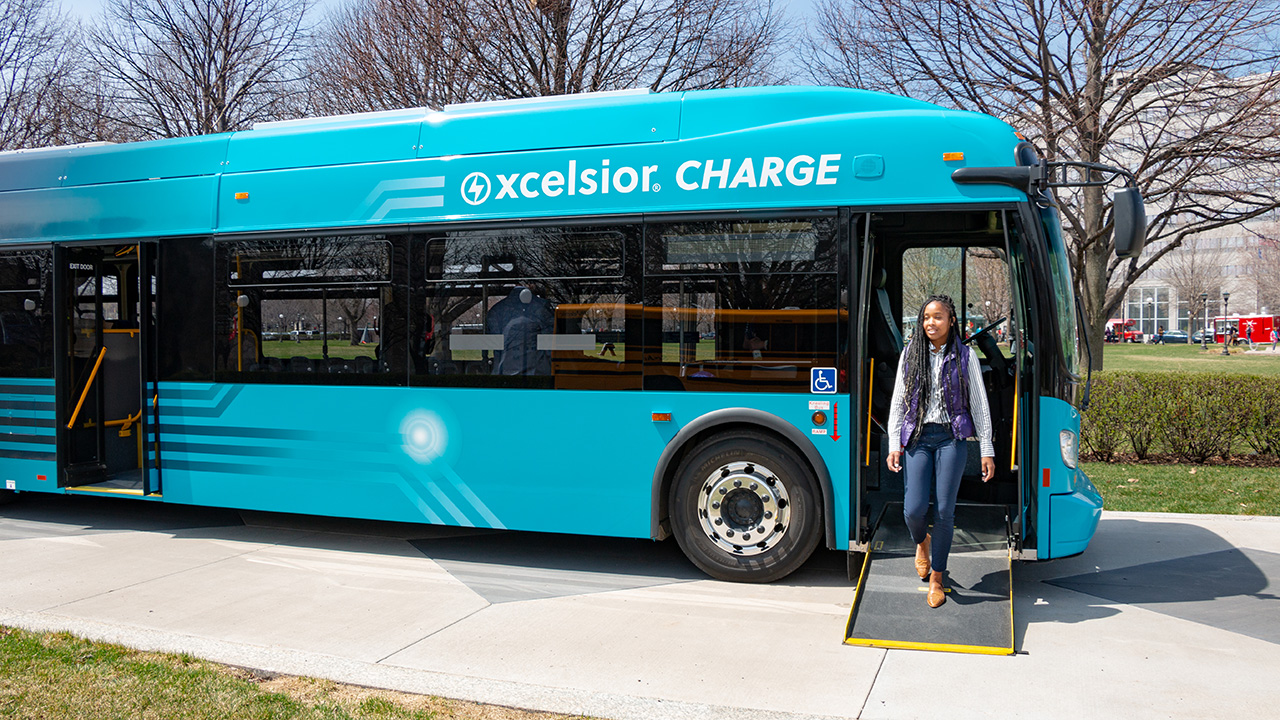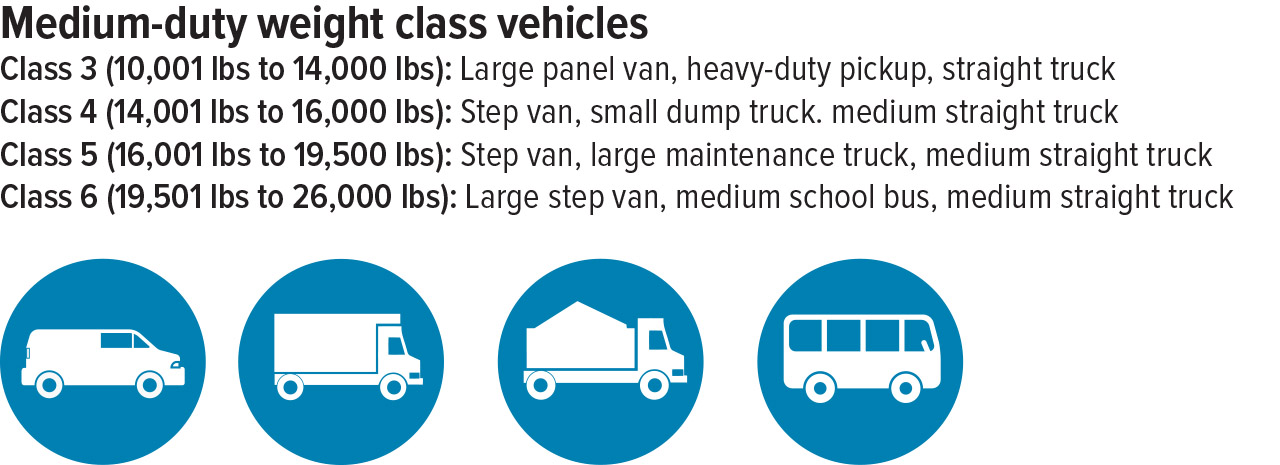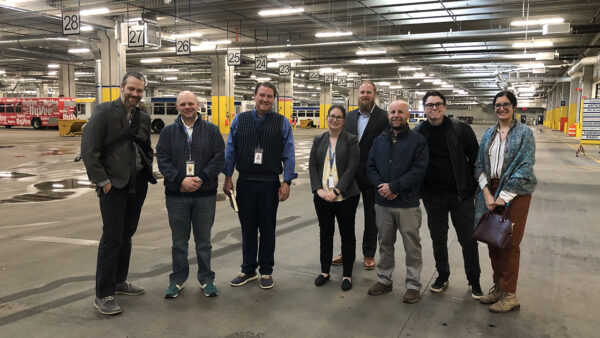
The transportation sector is currently the biggest emitter of greenhouse gas (GHG) pollution in both the United States and Minnesota, which makes it a top priority to decarbonize. One important way to reduce transportation emissions is to convert on-road internal-combustion engine (ICE) vehicles that run on fossil fuels to electric vehicles powered by clean electricity, especially for medium- and heavy-duty vehicles in Minnesota.
A Coalition for Clean Transportation report from 2023, which was created in collaboration with Fresh Energy, found that adopting policies that rapidly electrify vehicles could reap cumulative societal benefits of at least $9.9 billion and up to $18.5 billion between 2022 and 2050. Additionally, there are climate and community health benefits from electrifying vehicles, particularly for communities living near high-traffic roadways that are exposed to increased pollution.
But what’s the actual difference between light-, medium-, and heavy-duty vehicles? It’s a common question folks have when learning more about transportation policy. Every vehicle, whether it’s a small compact car or large farming rig, falls into one of these three vehicle classes determined by its weight, as set by the U.S. Department of Energy.
In this post, we’ll explain the three different vehicle classes, why it’s important to rapidly electrify our vehicles to reduce GHG emissions, recent federal policies to reduce transportation emissions, and how Fresh Energy is plugging in to help Minnesota meet its climate targets and improve public health.
What is a light-duty vehicle?
You’re likely very familiar with light-duty vehicles already—they’re the passenger vehicles that many of us use to get around! Light-duty vehicles have a Gross Vehicle Weight Rating (GVWR) below 10,000 pounds and can be further classified into classes 1 and 2, depending on their weight. Light-duty vehicles encompass almost all the standard vehicles people use in their every life, from cars, SUVs, minivans, and most pickup trucks and cargo vans.

What is a medium-duty vehicle?
A medium-duty vehicle is one with a GVWR between 10,000 and 26,000 pounds, and can be further classified into classes 3, 4, 5, and 6.
The most common medium-duty vehicles are flatbed tow trucks, large panel vans, large maintenance trucks, medium school buses, and step vans. This category also includes heavier pickup trucks with a one-ton payload capacity like Ford F-350s, Chevy Silverado 3500s, and Ram 3500s. (Trucks with a smaller payload of a half-ton or ¾-ton are typically light-duty vehicles, like Ford F-150s and Chevy Silverado 1500s, although these models have increased in size over the last decade.)
Medium-duty vehicles don’t typically require a commercial driver’s license (CDL) to operate, although they are usually required to stop at state weigh stations and inspection stations if they are used for business.

What is a heavy-duty vehicle?
A heavy-duty vehicle is one with a GVWR above 26,000 pounds, which includes vehicle classes 7 and 8. This includes 18-wheelers, garbage collection trucks, dump trucks, gas trucks, yard tractors, and farm equipment. Heavy-duty vehicles typically require a Class B CDL to operate, and most often are used for a specific purpose for some type of labor.
Class 7 heavy-duty vehicles include bigger school buses and transit buses, whereas Class 8 heavy-duty vehicles usually include coach buses, large transit buses, tractor-trailers, and large straight trucks.

Why is it important to electrify vehicles?
Our recent report on medium- and heavy-duty vehicles found that reducing the fuel we use in vehicles by electrifying them will reduce cumulative net greenhouse gas emissions by at least 35 million metric tons and up to 88 million metric tons through 2050. That’s the equivalent of removing more than seven million passenger vehicles from the road for one year.
Electrifying vehicles is also good for human health: These reductions in fuel use will reduce cumulative nitrogen oxide (NOx) and particulate matter (PM) emissions in Minnesota by over 85,000 and 750 tons, respectively, by 2050. We know that breathing elevated levels of NOx and PM emissions over long periods of time causes significant negative health impacts like asthma, heart disease, cancer, and premature death. Our report finds that shifting to medium- and heavy-duty electric vehicles in Minnesota would reduce premature deaths and cause fewer hospital admissions and emergency room visits for asthma, avoiding more than 100 premature deaths and nearly 100 hospital visits, which would save Minnesota more than $1.3 million in health-related costs.
Electrifying vehicles is also cost-effective in the long run as well: the report found that the average medium-/heavy-duty electric vehicle owner would save more than $16,000 over the life of the vehicle by 2030. It would also reduce total state annual fossil fuel use by at least 380 million gallons—and up to 8.2 billion gallons—by 2050. That’s great for Minnesotans’ pocketbooks and economy, since we can charge the vehicles with homegrown, clean energy from across the state instead of importing fossil fuels from elsewhere—and exporting our money in the process.
What recent federal policies are there to reduce emissions from medium- and heavy-duty vehicles?
The Environmental Protection Agency (EPA) recently finished its new heavy-duty vehicle performance standards, which will cut GHG emissions from heavy-duty trucks by 32 to 62 percent by 2032, compared to our current standards. This is a much less stringent target than was originally proposed and does not meet the pace that’s needed to reduce transportation emissions by mid-century. Notably, the performance standard is a missed opportunity for rapidly electrifying trucks to our manufacturing capabilities, and extending the use of diesel trucks that cause harm to communities through smog and particulate pollution.
Fresh Energy is also following the recent National Zero-Emission Freight Corridor Strategy from the Joint Office of Energy and Transportation, which will speed investments in medium- and heavy-duty infrastructure and advance both electric grid and hydrogen planning to create a zero-emission freight network by 2040. This program will identify and build the infrastructure that’s necessary to transition our freight network to zero-emission vehicles.
How Fresh Energy is plugging in to electrify medium- and heavy-duty vehicles
Fresh Energy is helping to jump-start the electrification of Minnesota’s transportation sector. We advocate for state and local policies in Minnesota to reap the benefits of zero-emission, carbon-free vehicles, including the electrification of school buses and expansion of clean public transit—both of which reduce emissions from dirty diesel trucks and create family-sustaining careers in the process. We advocate for smart, GHG-reducing policies as a member of the Coalition for Clean Transportation (CCT) and by participating as a stakeholder in electric utilities’ Transportation Electrification Plans (TEPs).



